In Arizona, Democrat Kyrsten Sinema runs hard to the middle, defying most of her party. Will it work?
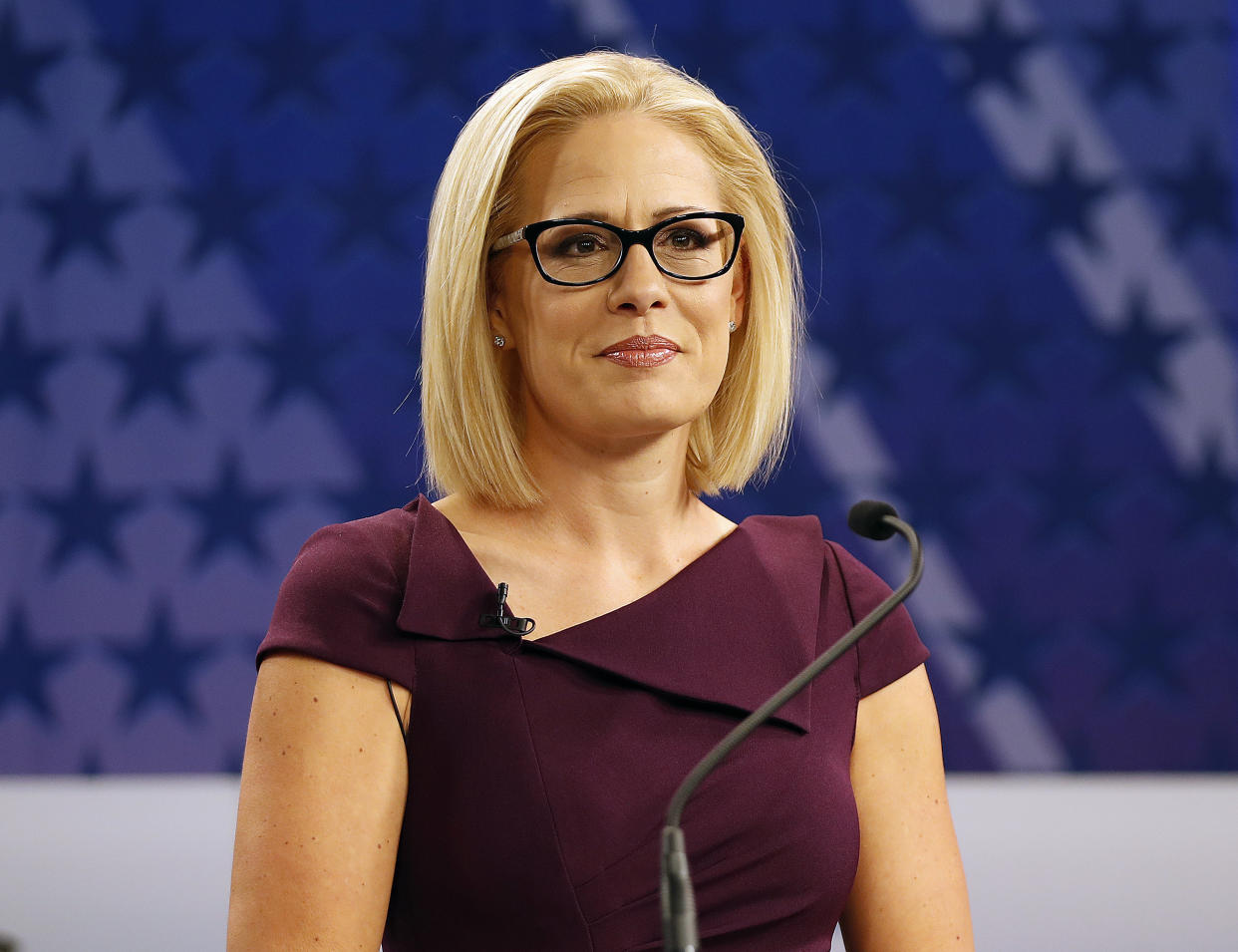
When Arizona Rep. Kyrsten Sinema announced last September that she would be running for Republican Jeff Flake’s Senate seat, Washington Democrats rejoiced.
They’d secured their “top recruit” for a race that represented one of only two purple-state pickup opportunities — a race that became even more winnable after Flake announced his retirement the following month. Elected in 2012 by a mere 10,000 votes to represent Arizona’s Ninth Congressional District, which curves around central Phoenix to the north, east and south, Sinema, a self-styled moderate, went on to win reelection by widening margins: 13 percentage points in 2014, 22 percentage points two years later. She also proved to be a prodigious fundraiser.
At the time, Washington Republicans didn’t say much. But it turns out they were excited as well at the chance to run against a candidate whose record they viewed as a handicap. Sinema “has one of the worst oppo files in the Democratic recruiting class,” Mitch McConnell’s former chief of staff recently explained, “and I think there were an awful lot of folks who thought that it would speak for itself.”
Her opponents are making sure it’s being heard. For the last month the GOP has been gleefully unloading all of its opposition research on Sinema. There’s the ad from Sinema’s Republican rival, Martha McSally (and the other ad, and the other ad), featuring a 15-year-old photo of Sinema protesting the Iraq War in a “pink tutu” as proof that the Democrat had once engaged in “denigrating” U.S. troops. (Politifact judged the accusation “mostly false.”) There are the reports that Sinema exaggerated the hardships she faced as a child while living for three years in an abandoned gas station with her family. There are the stories about Sinema calling Arizonans “crazy,” repeating a Jon Stewart joke likening her state to a “meth lab of democracy,” and inviting a coven of witches to one of her anti-war events.
“You said it was OK for Americans to join the Taliban to fight against us,” McSally, an Air Force veteran, said during a debate earlier this month, dredging up an offhand comment Sinema made during a 2003 radio interview. “Kyrsten, I want to ask right now … whether you’re going to apologize to the veterans and me for saying it was OK to commit treason.”
This, it seems, is McSally’s closing argument: that her opponent is actually a wacky, anti-military leftist and not the bipartisan centrist and relatively hawkish Democrat she claims to be.
So how is the massive oppo dump working out for McSally?
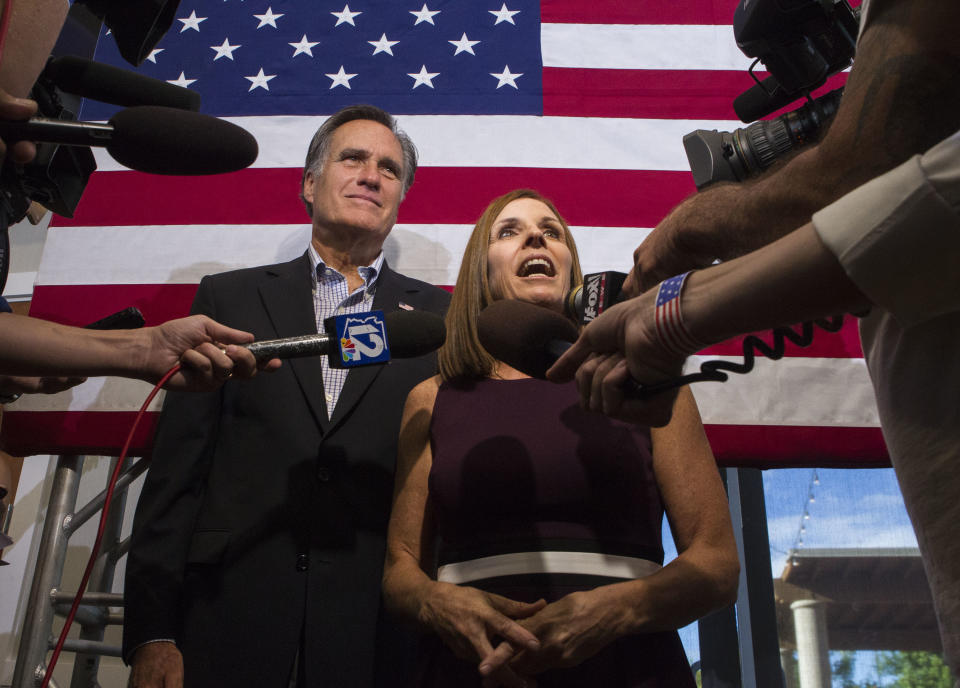
Not well enough, according to the latest polls. With less than a week to go until Election Day, Sinema leads by roughly two percentage points on average — which, after factoring in fundamentals such as fundraising, state voting patterns and historical trends, gives her a 60 percent chance of winning on Nov. 6, according to the data journalists at FiveThirtyEight.
One month ago, before the deluge, the site pegged Sinema’s chances at 64 percent.
How has Sinema managed to hold her slim lead? Besides a political climate that favors Democrats more broadly, three factors stand out. The first is that Sinema — a lapsed Mormon, openly bisexual, nontheist trailblazer, Ironman triathlete and former “Prada socialist” who was once described by the Washington Post as a “bracingly unfiltered talker” — has run perhaps the most disciplined campaign of 2018.
“Bracingly filtered” would be another way to put it. From the very beginning, Sinema made it clear that her campaign would depart from the prevailing view among progressives that if Democrats want to win back Congress, and eventually the White House, they should disregard America’s dwindling centrist bloc and focus instead on harnessing their own voters’ anger toward Donald Trump.
Trump is “not a thing,” Sinema insisted when the Arizona Republic asked about her message in one of the only news profiles she participated in during this election cycle. (Unlike her Democratic counterpart in Texas, Beto O’Rourke, Sinema has studiously avoided the national media.) She added that Trump is “not a part of what I think my constituents are worried about or think about.”
Nor, she added, is partisanship. “It’s not about a party,” Sinema said. “It never is about party. It’s about putting people ahead of party. I don’t think party matters much to people.”
Sinema has stuck to this script ever since, touting herself as a lawmaker who will work with “literally anyone who is willing to get something done” and intentionally omitting her political affiliation from her campaign ads. Asked in a recent interview whether she considers herself a “proud Democrat,” the candidate couldn’t bring herself to answer yes.
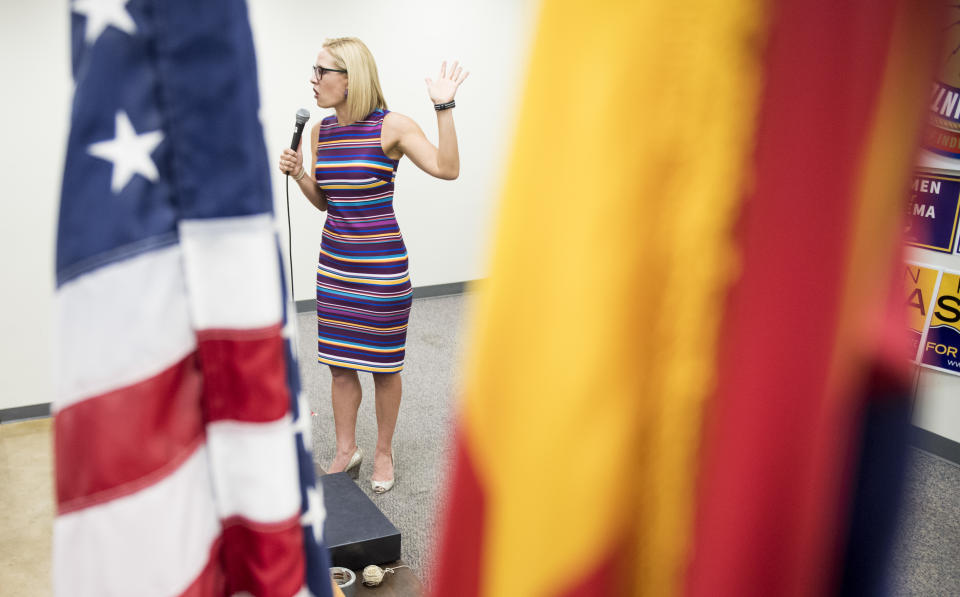
“Gosh, it’s hard to say ‘proud,’” she replied. “I would say that I’m a proud Arizonan. That’s something I’m very proud of.”
Such messaging would have struck voters as mere rhetoric if Sinema didn’t have the record to reinforce it. Which brings us to the second reason she has survived McSally’s onslaught: Sinema hasn’t acted like a left-wing warrior in a long time — not since her earliest days in elected office — and she has been frank about why she changed.
“A person who chooses to be a bomb thrower in the legislature is choosing to remove himself or herself from the work of the body: negotiating on bills, working to find compromises, and sometimes teaming up with unusual allies to promote or kill legislation,” Sinema wrote nearly a decade ago in her book Unite and Conquer: How to Build Coalitions That Win and Last, noting that her first two years in the state House of Representatives — her time as a bomb thrower — were a “miserable” experience.
“It didn’t fit me,” she continued. “I do love to give fiery speeches. But I also love people. I love talking with people, working together, and making friends.”
In the book, Sinema went on to blame the left’s shortcomings on an “obsession with victimhood” and to call on her side to reject “identity politics,” as Yahoo News’s Jon Ward has pointed out.
Only Sinema knows whether this shift stemmed from conviction or calculation. Either way, it’s hard to overstate how resolutely centrist she has remained during her nearly six years in Congress.
Sinema was one of just six House Democrats to vote for a GOP bill that would punish so-called sanctuary cities by withholding federal funds; one of just seven who voted to create a select committee to investigate the 2012 attack on the U.S. diplomatic compound in Benghazi, Libya; and one of just three who voted to make permanent some of the cuts in last year’s GOP tax bill. She has also joined the GOP in voting for legislation that would deregulate the banking industry, provide $1.6 billion for a border wall with Mexico, weaken Obamacare’s employer mandate and prevent Syrian and Iraqi refugees from being resettled in the United States until tighter vetting processes could be implemented. She has even voted against Nancy Pelosi for House minority leader — twice.
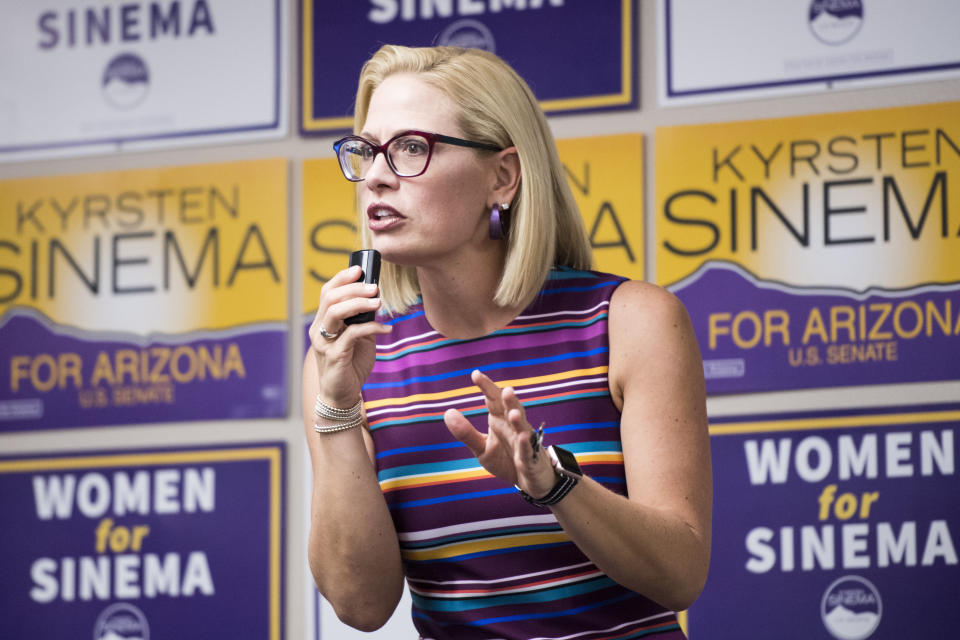
According to the Lugar Center, a bipartisan think tank, all of this makes Sinema the sixth-most bipartisan member of the House, and the third-most bipartisan Democrat. Meanwhile, FiveThirtyEight has determined that the congresswoman has voted with Trump 62.2 percent of the time — more often than all but three other House Democrats.
On the trail, Sinema boasts about talking infrastructure with Trump and watching him sign one of her bills; when the president recently reacted to the “caravan” of asylum-seeking Central American migrants by announcing that he would deploy 5,000 troops to the border, Sinema applauded. So it’s no surprise that many Arizonans aren’t buying the caricature of her as a tutu-wearing resistance fighter.
And then there’s the final reason Sinema is still afloat: McSally herself.
One of the highest-ranking female pilots in Air Force history, with a master’s degree from Harvard to boot, McSally twice won her Tucson-area swing district, even as Trump lost there to Hillary Clinton. She also has a well-documented record of skepticism toward, and even frustration with, the president. She never endorsed him in 2016. She opposed his plan to ban Muslims from entering the United States. She condemned his threat to ditch NATO. When Trump was caught on tape bragging about grabbing women’s genitals, she called the comments “disgusting” and “unacceptable.” Asked whether she eventually gave in and voted for the GOP nominee, McSally refused to answer. Throughout 2016 and 2017, she offered qualified support of increased border-security measures but stopped well short of backing Trump’s “wall.” “Not a continuous, 2,000-mile border wall, no,” she said during a town hall meeting with constituents.
McSally quickly changed course, however, when faced with not one but two pro-Trump primary opponents: former state legislator Kelli Ward and former Maricopa County Sheriff Joe Arpaio. She took a hard line against citizenship for minors brought to the United States by their undocumented parents, even though at one time she had supported the Recognizing America’s Children Act, which would have provided a pathway to citizenship for the so-called Dreamers, who were brought to the U.S. illegally as children. She claimed that she had “always supported building a wall” — a clear shift from her earlier, more nuanced position. She cultivated Trump’s endorsement, declaring the president a role model who has “done a lot of amazing things in his life.” And even after she secured the nomination, she continued to emphasize her newfound Trumpism, noting for crowds that she has voted with him nearly 98 percent of the time. Trump appeared in McSally’s debut campaign ad — “My friend Martha McSally, she’s the real deal,” he says onscreen — and alongside her at a rally in Phoenix two weeks ago. Since then, McSally has also rallied with Donald Trump Jr. and Mike Pence, and her final pitch to voters, like Trump’s, has centered on the so-called caravan.
“This caravan just shows the insanity of the border crisis that’s happening every single day here in Arizona,” McSally said Tuesday at an event designed to publicize her endorsements from three members of “angel families” — relatives of people killed by an illegal immigrant. “Every single day, everywhere I go, people are asking me about the caravan. Every single day, they are asking about what we are doing to secure our border.”
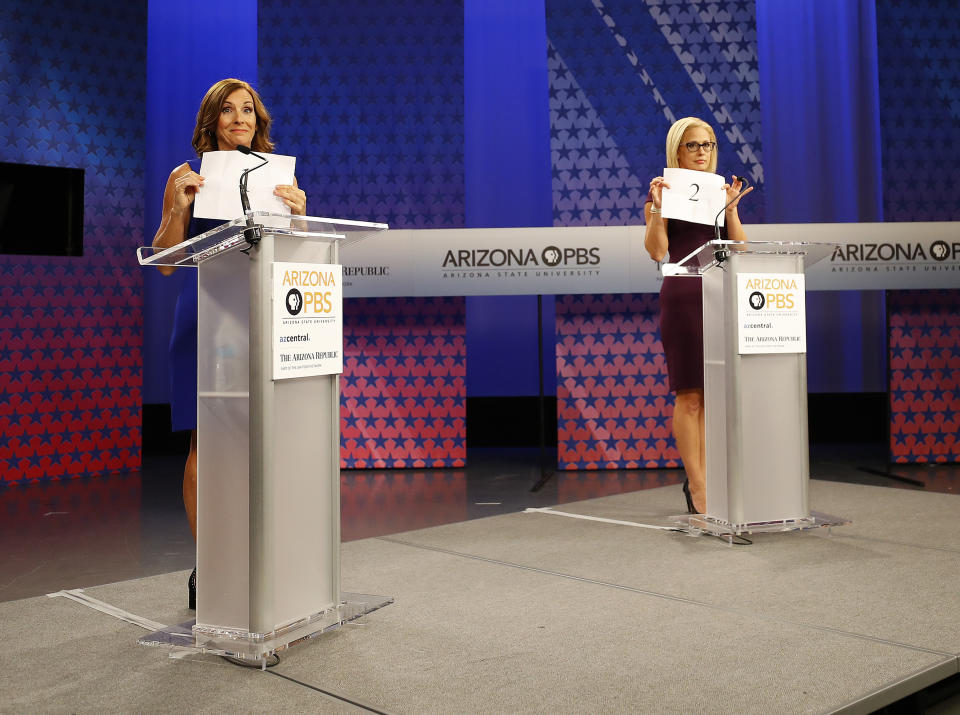
In short, both Sinema and McSally have centrist cred -— but only Sinema is campaigning on it. Time will tell whose strategy is smarter. To be sure, McSally hasn’t shed all of her idiosyncrasies. She is, for instance, one of the few Republican women who’s been willing to emphasize gender this cycle, speaking out about the challenges she faced as a female fighter pilot and a victim of sexual abuse; in one video, she urged Republicans to “grow a pair of ovaries.” And though Arizona has been trending purple — in 2012, Mitt Romney won there by 9 percentage points; four years later, Trump only managed to squeak past Hillary Clinton by 3 points — Republicans still outnumber independents or Democrats.
But just barely. (The registration numbers currently stand at 35 percent Republican, 33 percent independent and 31 percent Democrat.) Increasingly, Arizona’s broader population is dominated by two groups that especially dislike Trump: moderate, well-educated suburbanites clustered in the booming Phoenix metropolitan area, and Latinos, who now represent a fast-growing 31 percent of the state’s residents. As a result, the president’s approval rating in the state has plummeted 22 percentage points since his inauguration, and today more Arizonans disapprove than approve of his performance in office.
To capitalize on this shift, Sinema has spent her entire campaign hammering McSally on the crossover issue of health care — especially the Republican’s votes to repeal Obamacare, which would have allowed states to eliminate protections for people with preexisting conditions, and her support for GOP budget resolutions that would have voucherized Medicare.
Even McSally has admitted that the attacks are having an effect. “Well, Sean, I did vote to repeal and replace Obamacare on that House bill,” McSally told Sean Hannity last week. “And I’m getting my ass kicked for it right now.”
“We’ve got some moderate Republicans who seem to have drank Kyrsten Sinema’s Kool-Aid in the polling,” she added on a local radio show. “We need to bring them back home.”
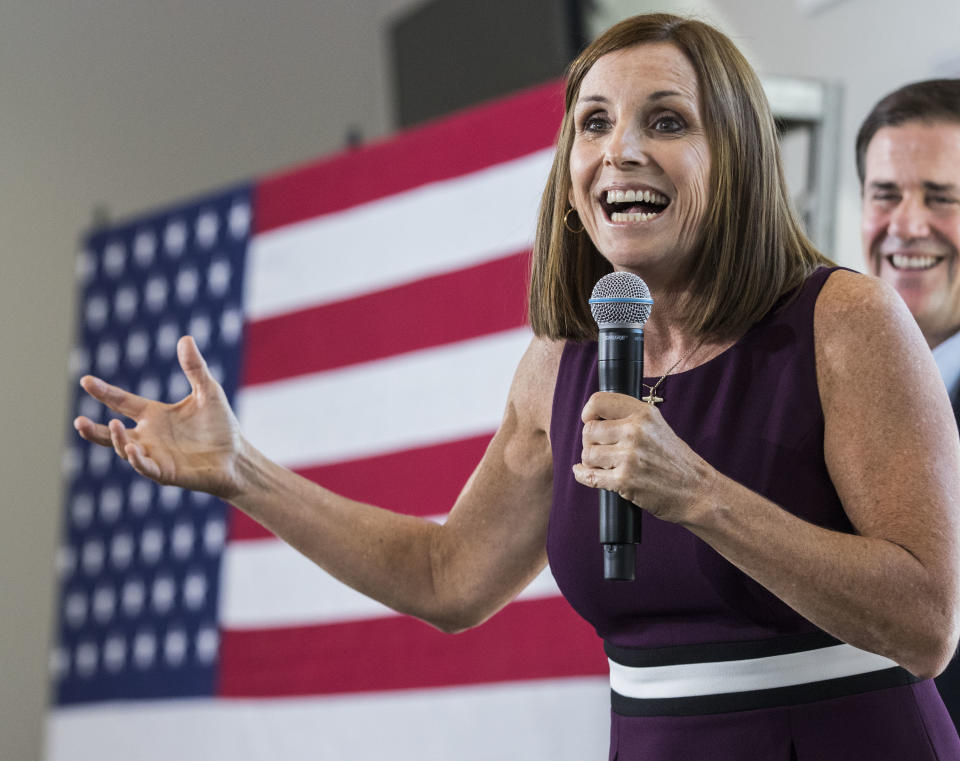
Whether McSally can succeed in doing that is an open question. The polls released this week suggest a tightening race; Fox News, which gave Sinema a two-point lead at the start October, now shows a tie; CNN, which had Sinema winning by seven points last month, now puts her ahead by four. One pattern is consistent across all surveys, however: While both McSally and Sinema lead by huge margins among their own partisans, Sinema always has a 10 to 20-point edge among independents or moderates.
In Arizona, Republicans are the most reliable voters, and as of last Friday, they led by 11 percentage points in early voting. If that trend continues through Nov. 6, McSally will likely win, vindicating her embrace of Trump. If, however, the center shows up, Sinema’s approach will carry the day — and she’ll be the next senator from Arizona. She may also prove that in the Age of Trump, despite what many Democrats believe, moving aggressively to the middle doesn’t have to be a fool’s errand.
_____
Read more Yahoo News midterms coverage:
In deep-red Missouri, McCaskill pursues voters far off the Democratic beaten path
With racial tension high in Florida race, Trump calls Gillum a ‘thief’
Menendez race pits ethical concerns against party loyalty, and loyalty is winning
Portrait of a moderate district: NJ-11 leans R, but the race leans D
Virginia Republican congressman tries to weather scandal and wave of spending



